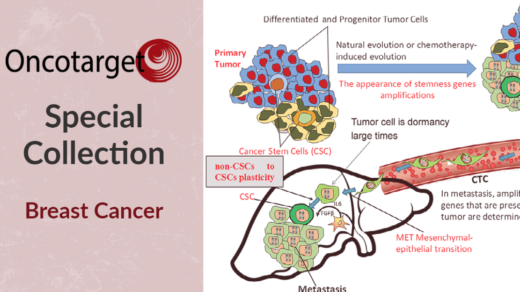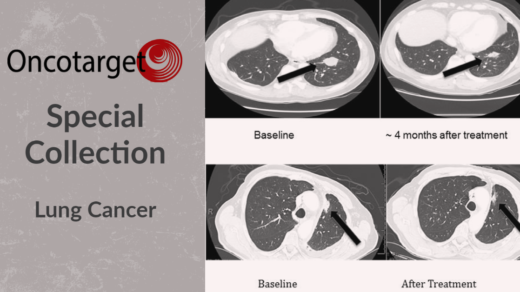Researchers developed a divergent strategy to treat non-small cell lung cancer (NSCLC).

The Trending with Impact series highlights Oncotarget publications attracting higher visibility among readers around the world online, in the news, and on social media—beyond normal readership levels. Look for future science news about the latest trending publications here, and at Oncotarget.com.
—
The mammalian target of rapamycin (mTOR) operates within two distinct protein complexes—mTOR complex 1 (mTORC1) and complex 2 (mTORC2). These protein complexes are not yet fully understood, as they were only recently identified in humans in 1994. What researchers do know is that mTORC1 is involved in the regulation of many cellular processes and is a key mediator of cell growth and proliferation. mTORC1 is activated by growth factor receptor signals through the PI3K–AKT and RAS–ERK mitogen-activated protein kinase (MAPK) pathways.
The PI3K/AKT/mTOR pathway may be an efficacious target in the treatment of patients with non-small cell lung cancer (NSCLC). This theory is based on the identification of particular gene mutations in NSCLC that are associated with the PI3K/AKT/mTOR pathway. However, previous studies have not yet succeeded in defining an effective monotherapy or combination of therapies that targets this pathway while improving NSCLC patient outcome.
Researchers from Institut Curie, PSL University, Xentech, BioPôle Alfort, Hôpital Foch, and Centre Léon Bérard designed a study using a new methodology to test treatment combinations based on specific targets identified as biomarkers of resistance to PI3K-targeting treatments, and not based on the NSCLC mutations themselves. Their trending research paper was published by Oncotarget in 2021 and entitled, “High in vitro and in vivo synergistic activity between mTORC1 and PLK1 inhibition in adenocarcinoma NSCLC.”
“Our main strategy was therefore, using a panel of NSCLC PDXs, (i) to define predictive markers of response to RAD001 therapy and (ii) to identify possible combinations of treatments that may be able to reverse RAD001 resistance.”
THE STUDY
Researchers tested RAD001/Everolimus (an mTORC1 inhibitor) in vivo using NSCLC Patient-Derived Xenografts (PDXs), which demonstrated high antitumor efficacy. They next aimed to define predictive markers of response to RAD001 using real-time quantitative RT-PCR assays.
“In order to define predictive markers of response to RAD001, we used real-time quantitative RT-PCR assays to quantify the mRNA expression of a large number of selected genes.”
The team found three significantly highly expressed and targetable genes in NSCLC tumors resistant to RAD001: PLK1, CXCR4 and AXL. They then analyzed these genes for their prognostic value among NSCLC patients that were found in the publicly available database KMPLOT. This analysis revealed that of the three genes evaluated, only one high-gene expression was correlated with a negative impact on overall survival of patients with adenocarcinoma: PLK1. Given this data, the researchers next evaluated the in vivo efficacy of RAD001 combined with a PLK1 inhibitor, volasertib, in four PDX models. The RAD001 + volasertib combination demonstrated dramatic efficacy in three of the four models.
“In all tested PDXs, except LCF29, we have observed a significant, but variable, improvement of the antitumor efficacy of RAD001 + volasertib in comparison to each monotherapy (Figure 2A).”
To define this RAD001 + volasertib drug combination’s mechanism of action, the researchers conducted a pharmacodynamics (PD) study. The team then evaluated post-therapeutic proteins involved in the cell cycle, vascularization and carbonic anhydrase IX expression. These results were then validated using in vitro studies.
CONCLUSION
“Our determination of relevant Pi3K-based therapeutic combination(s) was not supported, by the presence of actual molecular abnormalities, nor by physician therapeutic practices, but by the identification of predictive markers of resistance to Pi3K-based monotherapies.”
In summary, the researchers conclude that their study demonstrates that inhibiting both mTORC1 and PLK1 proteins induces synergistic antitumor activity in multiple models of NSCLC. In the discussion section of this paper, the authors detailed the divergent methodology they used to come to their conclusion.
“This methodology may promote more relevant clinical trials and avoid non-efficient combinations, inacceptable toxicities, and expensive and time-consuming studies.”
Click here to read the full research paper, published by Oncotarget.
YOU MAY ALSO LIKE: More Oncotarget Videos on LabTube
—
Oncotarget is a unique platform designed to house scientific studies in a journal format that is available for anyone to read—without a paywall making access more difficult. This means information that has the potential to benefit our societies from the inside out can be shared with friends, neighbors, colleagues, and other researchers, far and wide.
For media inquiries, please contact media@impactjournals.com.



